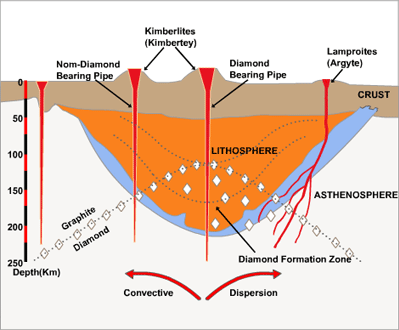

Around 3.2 billion years ago, as the continents took shape, hundreds of kilometres below the earth's surface, temperatures of up to 1,300°C, a unique crystalline lattice structure took shape – Natural Diamonds.
They formed in molten rock 145km to 200 km down, and some rare natural diamonds have originated even deeper, up to 400km. Powerful volcanic eruptions forced magma through the earth's upper mantle toward the surface at the speed of sound, too fast for their crystalline structure to degrade into the more common graphite. As the volcanoes eventually cooled, the diamonds remained trapped inside vast cones of hardened magma, known as Kimberlite,
Additionally, the term "alluvial diamonds" is used to refer to diamonds that have been eroded away from their original location in Kimberlite over the course of millions of years and subsequently deposited in new environments like river beds, ocean floors, or shorelines.

The diamond content of a kimberlite magma arriving at the earth's surface is defined by ascent processes. Once a pulse of magma arrives close to the earth's surface, the diamond distribution within the resulting consolidated Kimberlite depends on the final emplacement processes. Multiple pulses of Kimberlite typically form a single body, and each pulse has a different diamond content and emplacement history.
Exploration tools like geology, physics, geophysics, engineering, chemistry and biochemistry and understanding the geology and emplacement history of kimberlite bodies play a critical role from early exploration to mineral deposit evaluation, resource determination, deposit economics, mining and resource reconciliation.

We mine above ground and along the courses of ancient rivers and other alluvial deposits in Africa and always in partnership with our host communities. We work responsibly to make sure that, when diamonds are found, they play a central role in the community's efforts to create jobs, improve education and healthcare, and build infrastructure.

Diamonds are one-of-a-kind and cannot be duplicated. Therefore, determining the value of each rough diamond based on its cut, colour, clarity, and carat size (or the 4C) is a science that requires a trained eye, years of experience, and the most recent diamond sorting technology. This is done by sorting over 9,000 distinct categories of diamonds.
